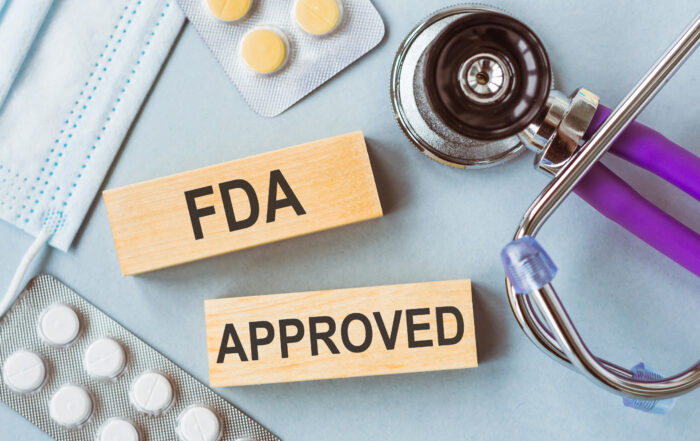
The Accelerated Approval Program: Desiderata for a Proper Solution to the Untimely Completion of Confirmatory Trials
By Omar Robles
Introduction
Starting in 1992, the U.S. Food and Drug Administration (FDA) instituted the Accelerated Approval (AA) program allowing drugs that treat serious medical conditions and fill an unmet medical need to be approved based on a surrogate endpoint. The surrogate endpoint used for AA is a marker—a laboratory measurement or other measure that is thought to predict clinical benefit but is not itself a measure of clinical benefit. For instance, the first drug to treat Duchenne muscular dystrophy (DMD) received AA based on the surrogate endpoint of increased skeletal muscle dystrophin, which FDA concluded was reasonably likely to predict a clinical benefit in some DMD patients.[1] In 2012, the Food and Drug Administration Safety Innovations Act further amended the Federal Food, Drug, and Cosmetic Act (FDCA) to allow FDA to expand its authority to use an intermediate clinical endpoint, a measure of therapeutic effect that is considered reasonably likely to predict the clinical benefit, as a basis for AA. Using a surrogate or intermediate clinical endpoint allows FDA to approve these drugs earlier than possible under traditional approval. FDA may approve a drug based on an “adequate and well controlled” study that demonstrates the drug has a beneficial effect on a surrogate or intermediate clinical endpoint when the latter is considered reasonably likely to predict a real clinical benefit. FDA bases its decision on whether to accept the proposed surrogate or intermediate clinical endpoint on the scientific support for that endpoint.[2]
Prior to receiving AA, a manufacturer is required to commit to a confirmatory trial protocol submission date, a completion date, and a study report submission date.[3] Moreover, AA is only granted if FDA agrees that the proposed timelines are reasonable. The Consolidated Appropriations Act of 2023 (CAA) gave FDA further discretion to require a manufacturer to initiate the confirmatory trial at the time of AA and mandated progress reports every six months.[4] After AA is granted, a manufacturer will still need to conduct a confirmatory study that verifies clinical benefit. FDA may withdraw approval of a drug or change the labeled indication for a drug if confirmatory trials fail to verify clinical benefit or do not demonstrate sufficient clinical benefit to justify the risks associated with the drug.[5]
At the outset of AA, FDA was concerned with the possible lack of due diligence in conducting post-approval trials to confirm clinical benefit.[6] Granting AA entails some risk that patients are exposed to adverse effects of an ineffective drug. That risk is reduced when confirmatory trials confirm a clinical benefit. However, a delay in confirmatory trials extends the risk of adverse effects to patients.
The due diligence in conducting confirmatory trials has been suboptimal in some cases. Johnson et al. found that the interval between AA and successful conversion to traditional approval for oncology products granted AA between December 1992 and July 2010 was more than five years for over 40% of confirmatory trials showing clinical benefit.[7] Frank et al. found that that only 50% of oncology drugs granted AA between 1992 and 2019 completed confirmatory trials within five years.[8] Deshmukh et al. found that more than half of completed confirmatory trials for drugs granted AA from January 2012 to July 2021 were completed late.[9]
In cases where a confirmatory trial fails to show a clinical benefit and the drug sponsor refuses to voluntarily withdraw its drug, FDA is required to hold a hearing, convene an advisory committee, and prepare extensive materials in support of withdrawal. In a recent example, the manufacturer of Makena refused to voluntarily withdraw the drug once FDA concluded that Makena lacked substantial evidence of effectiveness after a three-year delay in the confirmatory trial. Upon request for a hearing and a further three-year delay, FDA held a three-day hearing, convened a 15-person advisory panel, and prepared a docket of 241 documents. This recent example shows how an ineffective AA drug could remain on the market for years due to delays in confirmatory trials, while also highlighting the amount of time and resources required to withdraw the drug.[10]
While there are reasonable justifications for certain delays in confirmatory trials, unnecessary delays are of great concern. Such delays may result in prolonged use of drugs that do not demonstrate any clinical benefit or sufficient clinical benefit to justify the risks associated with the drug. On several occasions, FDA officials have asked Congress for greater authority to require companies to conduct more timely confirmatory trials of drugs granted AA and to expedite the process for withdrawing drugs when confirmatory trials fail to evidence sufficient clinical benefit.[11]
Desiderata
Several studies have examined the problem of delayed confirmatory trials and proposed policies to deter such delays; however, consensus on the latter remains elusive. Reaching consensus on appropriate policy to overcome this problem requires that we first identify the desiderata, the things desired, of an acceptable solution. Proposed desiderata for a proper solution to the untimely completion of confirmatory trials are discussed below.
1. Timely Completion of Confirmatory Trials
The first desideratum is that manufacturers complete confirmatory trials in a timely manner. This is, of course, the intended purpose of all proposed policies to deter unnecessary delays. One can hope that there is no disagreement on this desideratum.
2. Patients are Not Penalized for Delays in Confirmatory Trials
The second desideratum is that patients are not penalized for delays in confirmatory trials. Drugs are approved under AA on the presumption that they treat serious conditions and fill an unmet medical need. A drug that does not yet have evidence of clinical benefit does not equate to evidence of no clinical benefit. In other words, the absence of evidence is not evidence of absence. Consequently, withdrawing drugs from the market for the sole reason that confirmatory trials are delayed contradicts the very basis on which AA is granted and denies patients access to drugs deemed reasonably likely to treat serious conditions and fill an unmet medical need.
3. Integrity of Confirmatory Trials is Upheld
The third desideratum is that the integrity of confirmatory trials is upheld. The purpose of a confirmatory trial is to provide FDA with sufficient information to withdraw approval of a drug or change the labeled indication for a drug if the trial fails to verify clinical benefit or does not demonstrate sufficient clinical benefit to justify the risks associated with the drug. If the integrity of a clinical trial is compromised such that one cannot determine a clinical benefit or drug-associated risks, then the confirmatory trial will fail to achieve its intended purpose.
4. Drugs Suitable for AA are Not Deterred from Pursuing AA
The fourth desideratum is that drugs suitable for AA are not deterred from pursuing AA. Suitable drug applicants that are deterred from the AA program will expectedly turn to an alternative, protracted pathway, such as traditional approval. Consequently, this will result in delayed patient access to drugs that would have otherwise been available earlier through the AA program.
5. Minimize Additional Burden on FDA
The fifth desideratum is that the additional burden placed on FDA is minimized. FDA does not have unlimited resources to protect and advance public health. Any proposed policy, regardless of its suitability to the aforesaid desideratum, is limited by FDA’s capability to carry out that policy. Accordingly, reasonable policy proposals will minimize the additional burden placed on FDA, balance the burden with additional funding, or reduce FDA’s burden altogether.
Proposed Policy and Analysis
This section assesses commonly proposed solutions and a novel proposed solution based on their ability to satisfy the desiderata discussed above.
1. Mandate Initiation of Confirmatory Trials at Time of AA
The recently enacted CAA gave FDA further discretion to require a manufacturer to initiate the confirmatory trial at the time of AA and mandated progress reports every six months by manufacturers.[12] Several studies had proposed such a policy as a viable solution in the past. Johnson et al. determined that the role of AA in a development plan is not given sufficient time and attention: “there may be no confirmatory trial in progress, no protocol for a confirmatory trial, and no assurance that a trial protocol can be developed that will accrue patients.” As a solution, the authors considered establishing a requirement for a confirmatory trial to be in progress before granting AA because this would ensure AA is part of the drug development plan and not an afterthought.[13] Gyawali and Kesselheim (2018) and Shahzad and Wagner (2023) similarly argued that requiring confirmatory trials to be ongoing at the time of AA would minimize the period during which patients and physicians are using drugs approved through accelerated pathways without robust data demonstrating their efficacy and safety.[14]
Fashoyin-Aje et al. also found an association between preapproval initiation and faster completion of confirmatory trials for oncology indications that ultimately received traditional approval or were withdrawn.[15] Shahzad and Wagner, examining all AAs between September 2002 and December 2018, similarly found that AA indications with confirmatory trials started before approval had higher proportions of conversion to traditional approval or withdrawal at both year three and year five than indications that did not have pre-AA trial initiation.[16]
However, it is not clear if and how FDA will use its discretionary power or whether the compulsory start of a confirmatory trial ensures it will be completed in a timely manner. The finding of a positive association between preapproval initiation and faster completion of confirmatory trials may be the consequence of bias. As recognized by Shahzad et al., the reasons for starting confirmatory trials before or after AA are not known.[17] Drug manufacturers that were more proactive in initiating confirmatory trials may have also been more likely to complete them in a timely manner and voluntarily withdraw the drug when clinical benefit wasn’t verified. Whereas manufacturers that were less proactive about initiating confirmatory trials may have been less likely to complete them in a timely manner and less likely to voluntarily withdraw the drug when clinical benefit wasn’t verified. If so, the CAA may not fulfill expectations of achieving widespread, timely completion of confirmatory trials.
The CAA appears to be consistent with all the remaining desiderata. The policy does not directly affect patient access. The integrity of confirmatory trials is upheld. The policy prioritizes the planning and initiation of confirmatory trials. Suitable drugs are not deterred from the AA program. By contrast, drugs are on track to satisfy the confirmatory trial requirement of the AA program at the outset of AA. Lastly, the burden on FDA is possibly alleviated due to the mandate for recurring progress reports.
2.Withdraw Approval of Drugs that Fail to Complete Confirmatory Trials in Timely Manner
One recently proposed bill[18] would require AA to automatically expire after a defined period of time unless FDA confirms that the approval status is warranted. This would effectively make withdrawal automatic if a sponsor fails to provide sufficient evidence to warrant continued marketing approval.[19]
The proposed bill fails to meet several of the desiderata. First, removing a drug from the market when the only available evidence of efficacy is that the drug is reasonably likely to have better clinical benefit than the available therapy is not in the best interest of patients.[20] Second, the proposed policy may discourage manufacturers from seeking AA. The financial loss from withdrawing a drug from the market, even at low risk, can serve as a large deterrent to seeking AA in the first place. Consequently, manufacturers may instead turn to the traditional pathway, resulting in delayed patient access. Third, the bill places an additional burden on FDA. For every delayed confirmatory trial that FDA believes is reasonably likely to treat a serious condition, FDA must justify that the continued approval status is warranted as opposed to it being the status quo.
Moreover, the proposed policy may provide little-to-no additional incentive to complete confirmatory trials in a timely manner. Drugs are approved under AA on the presumption that they treat serious conditions and fill an unmet medical need. Withdrawing drugs from the market for the sole reason that confirmatory trials are delayed contradicts the very basis on which AA is granted. Consequently, a delay in confirmatory trials without any evidence of failed verification of clinical benefit or insufficient clinical benefit to justify drug-associated risks may inevitably lead to confirmation from FDA that continued approval is warranted. If so, the threat of withdrawal by FDA will be seen as a non-credible threat.
3. Restricted Pricing for Drugs Prior to Conversion
Restricting the price of drugs until such time that drugs granted AA are converted to traditional approval is a commonly proposed option. The intent is to create a disincentive (i.e., diminished profitability) for manufacturers to delay conversion. This can either be done directly through price controls or indirectly through taxes. For example, Gyawali and Kesselheim proposed the design of a new system to ensure that the prices of drugs granted AA are tied to their clinical value or cost of research and development until their true benefits are evaluated in post-approval trials.[21] Frank et al. propose legislation allowing the Centers for Medicare & Medicaid Services (CMS) to adjust administered prices under Part B of traditional Medicare based on successful completion of confirmatory trials.[22]
However, restrictions on pricing may discourage suitable drug applicants from pursuing AA over traditional approval because restricted pricing can put manufacturers in a difficult position. First, let’s consider the case of a direct restriction on drug prices. A substantial price increase for a drug that has been on the market for years at a lower price will almost certainly face significant backlash. Moreover, the fact that the price increase is effectively the result of verifying clinical benefit may be seen as nothing short of sanctimonious: touting the effectiveness of a drug yet simultaneously making it less accessible to those with a medical need. In the alternative, manufacturers that increase the price moderately will face a significant and prolonged adverse impact on profitability. At the risk of facing this scenario, manufacturers may find traditional drug approval to be a more suitable option than AA.
Second, let’s consider the case of an indirect restriction on drug prices, such as a tax. The creation and implementation of a tax is costly. These costs include, but are not necessarily limited to, the process of identifying, documenting, and assessing the drug revenues to be taxed as well as the collection of the tax and enforcement. Moreover, a tax can create a conflict of interest for FDA, or at least a perception thereof. Even if not channeled to the FDA, the collection of tax revenues resulting from an unverified clinical benefit may call into question the integrity of the FDA as a protector of public health that ensures the safety, efficacy, and security of drugs, yet benefits financially from delays in confirmatory trials. Consequently, a tax may, at the very least, place an additional burden on FDA and other government entities. However, there are far broader concerns with taxation as a general matter that have been well documented in the economic literature, such as deadweight loss.
4. Restricting Statutory Exclusivity of Drugs with Delayed Confirmatory Trials
A novel suggestion is to restructure existing statutory exclusivities to allow the self-interests of manufacturers to bring about the timely completion of confirmatory trials. Drugs that receive AA are given the same statutory exclusivities as those approved through the traditional pathway bestowed by the Drug Price Competition and Patent Term Restoration Act of 1984 (the Hatch–Waxman Act), the Biologics Price Competition and Innovation Act of 2009 (BPCIA), and several other laws. These statutory exclusivities are meant to provide manufacturers with an incentive to take on the costly and risky endeavor of developing drugs and bringing them to the market. Yet, the AA program effectively allows manufacturers to reduce both the cost and risk of bringing a drug to market while benefitting from the same statutory exclusivities as drugs that receive approval through the traditional pathway.
Several studies have shown that the drug development process is a timely, costly, and risky endeavor. Drug candidates often fail to successfully navigate through each successive phase of a clinical trial and reach the market.[23] By comparison, a drug that is granted AA reaches the market several years sooner and bypasses a sizable portion of the drug development process in doing so. The process of using a surrogate endpoint, rather than a clinical benefit, can considerably shorten the development time required prior to receiving FDA approval.[24] For example, Beaver et al. showed that the median time from AA to verification of clinical benefit was 3.4 years for malignant hematology and oncology products that were approved over a 25-year period.[25]
Statutory exclusivities provide a strong economic incentive for drug development.[26] The Hatch–Waxman Act and BPCIA bolster the incentive for innovation by providing a period of market exclusivity for small and large molecule drugs, respectively. Among other things, the Hatch–Waxman Act restricts approval of a generic drug for a five-year period when the reference drug is a new chemical entity (NCE), extends the life of patents to partially offset the period consumed by regulatory review (Patent Term Restoration), and restricts approval of generic drugs for a 30-month period after the branded drug’s patents are challenged (the 30-month stay). The BPCIA restricts the licensing of a biosimilar for a 12-year period after licensing the reference product. Moreover, drugs meeting certain conditions can receive additional forms of statutory exclusivity,[27] such as Orphan Drug Exclusivity (ODE), Generating Antibiotic Incentives Now Exclusivity, and Pediatric Exclusivity.
While a manufacturer must still engage in the risky and costly endeavor of a confirmatory trial after AA, the manufacturer also benefits from early market access. First, the manufacturer can offset the financial risk of a confirmatory trial with revenues from drug sales. Under traditional approval, the manufacturer must incur the cost and risk of clinical trials without guarantee of reaching the market. Whereas manufacturers can fund some or all of the costs of confirmatory trials with sales of the drug, irrespective of whether the drug fails to verify clinical benefit or sufficient clinical benefit to justify the risks associated with the drug. Second, earlier market access allows for longer patent protection after FDA approval when patents are issued during the drug development period. In those cases, the duration of clinical trials and FDA review erode the period of patent protection available after FDA approval. Consequently, only a fraction of patent life can remain once a drug receives FDA approval. Earlier FDA approval shifts a portion of the patent life that is eroded during the drug development period to the post-approval period. A longer period of patent protection after AA gives manufacturers a longer opportunity to capitalize on that protection.
In this regard, policy is at one extreme of the spectrum, providing manufacturers with an incentive to develop and bring drugs to market but no incentive to complete confirmatory trials in a timely manner. A simple yet effective policy change would be to grant statutory exclusivities upon AA but subsequently repeal those exclusivities when confirmatory trials fail to be completed in a timely manner. Exclusivity attaches upon approval of a drug if the statutory requirements are met.[28] Current policy can be modified to make the timely completion of confirmatory trials an additional statutory requirement. If the new statutory requirement is not met, then statutory exclusivity is no longer attached to the drug. The looming risk of restricted statutory exclusivities increases the threat of prompt competition. This restructured policy will provide manufacturers with the direct economic incentive to attain AA as well as the incentive to complete confirmatory trials in a timely manner.
Manufacturers have an incentive to pursue AA so long as they have a reasonable expectation of meeting the mutually agreed upon timelines set at the time of AA. Of course, accommodation can be made when delays are due to unexpected and overwhelming challenges like the COVID-19 crisis. Conversely, manufacturers that do not have a reasonable expectation of meeting the mutually agreed upon timelines or cannot come to an agreement with FDA are not suitable for the AA program and should instead opt for traditional approval. If increased competition is triggered by a delay in confirmatory trials, society can benefit in multiple ways. Increased competition can result in lower drug prices. In addition, reduced statutory exclusivities will create market opportunities that can drive innovation for new drugs. Consequently, the proposed policy will preserve patient access to these drugs and possibly allow for access to new drugs. Regarding the burden placed on FDA, the proposed policy does not materially add to FDA’s current burdens of assessing the progress of confirmatory trials and tracking statutory exclusivities.
Conclusion
The Accelerated Approval program allows for earlier approval of drugs that treat serious conditions and fill an unmet medical need based on a surrogate endpoint. A central concern with AA is how it can potentially cause unnecessary delays in confirmatory trials, resulting in prolonged use of drugs that have neither verified clinical benefit nor sufficient clinical benefit to justify the risks associated with the drug. While several studies have examined this problem and proposed policies to deter such delays, consensus on the latter remains elusive.
Reaching consensus on suitable policy to overcome this problem requires that we first identify the desiderata of an acceptable solution and then assess proposed policies based on their capacity to satisfy the desiderata. To this end, we propose five desiderata for evaluating proposed solutions: 1) timely completion of confirmatory trials; 2) patients are not penalized for delays in confirmatory trials; 3) integrity of confirmatory trials is upheld; 4) drugs suitable for AA are not deterred from pursuing AA; and 5) minimize additional burden on FDA. However, prior proposed solutions as well as recent legislation fall short of meeting these desiderata.
A novel solution to restructure existing statutory exclusivities to allow the self-interests of manufacturers to bring about the timely completion of confirmatory trials is more promising. For decades, statutory exclusivities have motivated manufacturers to develop and bring drugs to market. In that time, countless lives have benefited from the numerous novel drugs brought to market as a result. The challenge of unnecessary delays in confirmatory trials can be overcome by, once again, aligning the interest of public health with the self-interests of manufacturers.
[1] Press Release, U.S. Food & Drug Admin., FDA Grants Accelerated Approval to First Drug for Duchenne Muscular Dystrophy (Sept. 19, 2016), https://www.fda.gov/news-events/press-announcements/fda-grants-accelerated-approval-first-drug-duchenne-muscular-dystrophy.
[2] Accelerated Approval, U.S. Food & Drug Admin. (Feb. 24, 2023), https://www.fda.gov/patients/fast-track-breakthrough-therapy-accelerated-approval-priority-review/accelerated-approval.
[3] John R. Johnson, Yang-Min Ning, Ann Farrell, Robert Justice, Patricia Keegan & Richard Pazdur, Accelerated Approval of Oncology Products: The Food and Drug Administration Experience, 103 J. Nat’l Cancer Inst. 636 (2011).
[4] Consolidated Appropriations Act, 2023, P.L. 117-328, 136 Stat. 4459 (2022), https://www.congress.gov/bill/117th-congress/house-bill/2617/text.
[5] Accelerated Approval, supra note 2.
[6] Johnson et al., supra note 3.
[7] Id.
[8] Richard G. Frank, Mahnum Shahzad & Ezekiel J. Emanuel, Accelerated Approval of Cancer Drugs: No Economic Reward for Drug Makers That Conduct Confirmatory Trials, 41 Health Affs. 1273 (2022).
[9] Anjali D. Deshmukh, Aaron S. Kesselheim & Benjamin N. Rome, Timing of Confirmatory Trials for Drugs Granted Accelerated Approval Based on Surrogate Measures From 2012 to 2021, 4 JAMA Health Forum e230217 (2023).
[10] Daniel G. Aaron, I. Glenn Cohen & Eli Y. Adashi, The FDA Struggle to Withdraw Makena: Problems With the Accelerated Approval Process, 328 JAMA 2394 (2022).
[11] Rachel E. Sachs, Julie M. Donohue & Stacie B. Dusetzina, Accelerated Approval—Taking the FDA’s Concerns Seriously, 387 New Eng. J. Med. 199 (2022).
[12] Consolidated Appropriations Act, 2023.
[13] Johnson et al., supra note 3.
[14] Mahnum Shahzad, Huseyin Naci & Anita K. Wagner, Association Between Preapproval Confirmatory Trial Initiation and Conversion to Traditional Approval or Withdrawal in the FDA Accelerated Approval Pathway, 329 JAMA 760 (2023); Bishal Gyawali & Aaron S. Kesselheim, Reinforcing the Social Compromise of Accelerated Approval, 15 Nat. Revs. Clinical Oncology 596 (2018).
[15] Lola A. Fashoyin-Aje, Gautam U. Mehta, Julia A. Beaver & Richard Pazdur, The On- and Off-Ramps of Oncology Accelerated Approval, 387 New Eng. J. Med. 1439 (2022).
[16] Shahzad et al., supra note 14.
[17] Id.
[18] Accelerated Approval Integrity Act of 2022, H.R. 6963, 117th Cong. (2022), https://www.govinfo.gov/content/pkg/BILLS-117hr6963ih/pdf/BILLS-117hr6963ih.pdf.
[19] Aaron et al., supra note 10.
[20] Johnson et al., supra note 3.
[21] Gyawali & Kesselheim, supra note 14.
[22] Frank et al., supra note 8.
[23] Steve Morgan, Paul Grootendorst, Joel Lexchin, Colleen Cunningham & Devon Greyson, The Cost of Drug Development: A Systematic Review, 100 Health Pol’y 4 (2011).
[24] Accelerated Approval Program, U.S. Food and Drug Admin. (May 30, 2023), https://www.fda.gov/drugs/nda-and-bla-approvals/accelerated-approval-program.
[25] Julia A. Beaver, Lynn J. Howie, Lorraine Pelosof, Tamy Kim, Jinzhong Liu, Kirsten B. Goldberg, Rajeshwari Sridhara, Gideon M. Blumenthal, Ann T. Farrell, Patricia Keegan, Richard Pazdur & Paul G. Kluetz, A 25-Year Experience of US Food and Drug Administration Accelerated Approval of Malignant Hematology and Oncology Drugs and Biologics: A Review, 4 JAMA Oncology 849 (2018).
[26] Aaron S. Kesselheim, Using Market-Exclusivity Incentives to Promote Pharmaceutical Innovation, 363 New Eng. J. Med. 1855 (2010).
[27] Frequently Asked Questions on Patents and Exclusivity, U.S. Food & Drug Admin. (Feb. 5, 2020), https://www.fda.gov/drugs/development-approval-process-drugs/frequently-asked-questions-patents-and-exclusivity.
[28] Id.
Update Magazine
Winter 2023

 OMAR ROBLES is Managing Partner at economic consulting firm Emerging Health, LLC and Research Fellow at the Mossavar-Rahmani Center for Business and Government at the Harvard Kennedy School.
OMAR ROBLES is Managing Partner at economic consulting firm Emerging Health, LLC and Research Fellow at the Mossavar-Rahmani Center for Business and Government at the Harvard Kennedy School.




